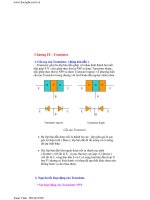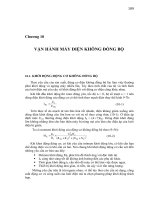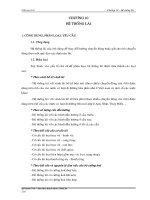10 LSWI variability+uncertainty
Bạn đang xem bản rút gọn của tài liệu. Xem và tải ngay bản đầy đủ của tài liệu tại đây (4.25 MB, 58 trang )
Power Systems & Energy Course
Large-Scale Wind
and Solar Integration:
Dealing with Variability
and Uncertainty
Jason MacDowell
2
An Introduction to Today’s 2 Lectures…
Focus on utility-scale wind and solar
What’s different about wind and solar?
Mitigating operational impacts
Key lessons learned from studies and operational
experiences
2016International,
General Electric
All Rights
© 2016 General ©
Electric
Inc. AllCompany.
rights reserved.
Not forReserved
distribution without permission.
2
3
Successful integration of high penetrations of wind
IMPORTANCE OF BUILDING ON SUCCESSES IN OTHER REGIONS
AND LEARNING FROM THEIR MISTAKES
Source: DOE/LBNL, 2015 Wind Technologies Market Report
© 2016 General Electric International, Inc. All rights reserved. Not for distribution without permission.
3
Moderate annual
average penetration
means high
instantaneous
penetrations
Source: AWEA (2/22/16)
and Ventyx (top). S.
Beuning, Xcel, 2011
(bottom).
© 2016 General Electric International, Inc. All rights reserved. Not for distribution without permission.
© 2016 General Electric Company. All Rights Reserved
4
5
We can successfully integrate high
penetrations of solar
Source: Rothleder, CAISO, UVIG 2016
© 2016 General Electric International, Inc. All rights reserved. Not for distribution without permission.
© 2016 General Electric Company. All Rights Reserved
5
6
How do you effectively integrate
wind and solar?
Cost-effective, efficient integration of wind and solar
Can be done through markets (RTOs) or verticallyintegrated utilities
Actions that increase operational efficiency are
generally the same actions that help integrate
renewables
Systems approach is critical
Requires cooperation: utilities, RTOs,
developers/owners, regulators/policymakers
© 2016 General Electric International, Inc. All rights reserved. Not for distribution without permission.
© 2016 General Electric Company. All Rights Reserved
6
7
What Makes Wind/Solar Different?
Zero marginal cost
• Cycling impacts on other generation
• Cost recovery impacts on other generation
System Balancing
• Variability and uncertainty
• Load is also variable and uncertain
Reliability and stability
• Inverter-based, non-synchronous generation
• Essential reliability services
• Weak grid
Location
• Remote, with long transmission
• Distributed energy resources, behind the meter
© 2016 General Electric Company. All Rights Reserved
© 2016 General Electric International, Inc. All rights reserved. Not for distribution without permission.
7
Overview
• Temporal/Spatial Patterns
• Variability in Wind and Load MW
Solar Variability
• Uncertainty
• Forecasting for Wind Power
Value of Improved Forecasts in Grid Operations
© 2016 General Electric International, Inc. All rights reserved. Not for distribution without permission.
8
GE’s Integration of Renewables Experience
2010 New England
Studies commissioned by utilities, commissions, ISOs...
• Examine feasibility of 100+ GW of new renewables
• Consider operability, costs, emissions, transmission
12 GW Wind
39% Peak Load
24% Energy
2008 Maui
70 MW Wind
39% Peak Load
25% Energy
2010 Oahu
500 MW Wind
100 MW Solar
55% Peak Load
25% Energy
2012 NSPI Study
900MW Wind
25% Energy
PJM Study (underway)
96GW Wind
22GW Solar
30% Energy
Gradients indicate systems subject to individual studies and also included in larger regional studies
2004 New York
3 GW Wind
10% Peak Load
4% Energy
2005 Ontario
15 GW Wind
50% Peak Load
30% Energy
2006 California
13 GW Wind
3 GW Solar
26% Peak Load
15% Energy
2007 Texas
15 GW Wind
25% Peak Load
17% Energy
2009 Western U.S.
72 GW Wind
15 GW Solar
50% Peak Load
27% Energy
Pan-Canadian
~72GW Wind
30% Energy
Universal need for fleet flexibility, new operating strategies and
markets, transmission reinforcement, grid friendly renewables
© 2016 General Electric International, Inc. All rights reserved. Not for distribution without permission.
9
Planning and
Operation Process
1 Year
Unit Dispatch
700
Resource and
Capacity Planning
(Reliability)
Capacity Valuation
(UCAP, ICAP)
and
Long-Term Load
Growth Forecasting
600
500
MW
Slower (Years)
Time Scales for
System Planning
and Operation
Processes
Technology
Issues
400
300
200
100
0
0
2000
4000
6000
8000
Hour
2001 Average Load vs Average Wind
1 Day
30,000
1,600
1,400
1,000
15,000
800
600
10,000
400
Wind Output (MW)
1,200
20,000
5,000
July load
August load
July w ind
200
Septem ber load
August w ind
Septem ber w ind
0
0
1
6
11
16
21
Hour
3000
3 Hours
2500
Load Following
(5 Minute Dispatch)
Faster (seconds)
Day-ahead and
Multi-Day
Forecasting
NYISO Load (MW)
Unit Commitment
and
Day-Ahead
Scheduling
Hour-Ahead
Forecasting
and
Plant Active Power
Maneuvering and
Management
2000
MW
Time Frame
25,000
1500
1000
500
0
1
61
121
M inu te s
September Morning
Frequency and
Tie-Line Regulation
(AGC)
Real-Time and
Autonomous Protection
and Control Functions
(AGC, LVRT, PSS,
Governor, V-Reg, etc.)
© 2016 General Electric International, Inc. All rights reserved. Not for distribution without permission.
A ugus t Morning
May Ev ening
Oc tober Ev ening
April Af ternoon
10 Minutes
10
50000
5000
40000
4000
30000
3000
Average Load
20000
Average L-W-S
Wind & Solar tend to
be complementary.
2000
Average Wind
Wind & Solar (MW)
Load (MW)
Temporal Pattern: July 2003 Average Day
(California)
Average Solar
10000
1000
0
0
1
5
9
13
17
21
Hour
© 2016 General Electric International, Inc. All rights reserved. Not for distribution without permission.
11
Temporal Pattern: January 2002 Average Day
(California)
50000
5000
Average Load
Average L-W-S
Average Wind
4000
Average Solar
30000
3000
20000
2000
10000
1000
0
Wind & Solar (MW)
Load (MW)
40000
0
1
5
9
13
17
21
Hour
© 2016 General Electric International, Inc. All rights reserved. Not for distribution without permission.
12
Temporal Pattern: All Days of July 2003
55000
15000
10000
Load (MW)
40000
Significant day-to-day
variation
25000
5000
10000
0
1
5
9
13
Hour
17
Wind & Solar (MW)
Average Load
Average Wind
Average Solar
21
© 2016 General Electric International, Inc. All rights reserved. Not for distribution without permission.
13
Temporal Pattern: All Days of January 2003
50000
10000
8000
30000
6000
20000
4000
10000
2000
0
Wind & Solar (MW)
40000
Load (MW)
Day-to-day variation in Wind is
higher in winter than in summer
Average Load
Average Wind
Average Solar
0
1
5
9
13
Hour
17
21
© 2016 General Electric International, Inc. All rights reserved. Not for distribution without permission.
14
Variability and Uncertainty…Layperson’s terms
For Example…
Generator Owner… “I can guarantee 1000MW of hydro all day tomorrow.”
System Operator… “OK, I will turn off 1000MW of other generation.
Variability:
Generator Owner...“I can guarantee 1000MW of hydro from 2PM to 4PM
tomorrow.”
System Operator… “OK, I may turn down 1000MW of other generation,
rather then shutting it off.”
Uncertainty:
Generator Owner… “I think I will have 1000MW of hydro sometime
tomorrow.”
System Operator… “OK, I may turn off only 600MW of other generation
and I will keep 400MW spinning and have quick start capacity ready to
fire.”
© 2016 General Electric International, Inc. All rights reserved. Not for distribution without permission.
15
Western Wind and Solar Integration Study
“To help multiple utilities in the western U.S. understand the
costs and operating impacts of the variability and uncertainty
of wind and solar power on their grids and potential mitigation
options for these impacts.”
Wind and Solar Combinations (% Energy)
Baseline:
Existing Wind and Solar Generation
10% In-Area: 10% Wind, 1% Solar In Footprint
10% Wind, 1% Solar Out of Footprint
20% In-Area: 20% Wind, 3% Solar In Footprint
10% Wind, 1% Solar Out of Footprint
30% In-Area: 30% Wind, 5% Solar In Footprint
20% Wind, 3% Solar Out of Footprint
Solar Mix:
• 70% Concentrating Solar Plant with Storage
• 30% Photo-voltaic
© 2016 General Electric International, Inc. All rights reserved. Not for distribution without permission.
16
Study Footprint Total Load, Wind and Solar Variation Over Month of July
(30% Wind Energy in Footprint)
LP Scenario
60000
50000
Load
MW
40000
30000
Ld(Base)
Wd(30%)
20000
PV(30%)
Wind
CSP(30%)
10000
0
1-Jul
8-Jul
15-Jul
22-Jul
29-Jul
© 2016 General Electric International, Inc. All rights reserved. Not for distribution without permission.
17
Study Footprint Total Load, Wind and Solar Variation Over Month of April
(30% Wind Energy in Footprint)
35000
Load
LP Scenario
30000
25000
Ld(Base)
Wd(30%)
PV(30%)
20000
MW
CSP(30%)
15000
10000
Wind
5000
0
-5000
1-Apr
8-Apr
15-Apr
22-Apr
29-Apr
Day
© 2016 General Electric International, Inc. All rights reserved. Not for distribution without permission.
18
Monthly Energy GWh from Wind & Solar for Years 2004–2006
4000
(30% Wind Energy - In Area Scenario)
Study Area Total Monthly Wind and Solar Energy for 2004 - 2006
2000
12000
‘06
PV
CSPws
Wind
0
10000
Jan
Feb
Total Energy (GWh)
‘05
8000
‘04
6000
4000
2000
0
Jan
Feb
Mar
Apr
May
Jun
Jul
Month of Year
Aug
Sep
Oct
Nov
Dec
Notable difference in Wind & Solar energy
across the months and over the years
© 2016 General Electric International, Inc. All rights reserved. Not for distribution without permission.
19
Monthly Energy % from Wind & Solar for Years 2004–2006
4000
(30% Wind Energy - In Area Scenario)
Study Area Percent Monthly Wind and Solar Energy for 2004 - 2006
06
60%
% of Load Energy
0
Jan
Feb
‘05
40%
30%
CSPws
Wind
‘06
50%
PV
2000
55% of energy
from wind and
solar
‘04
20%
10%
0%
Jan
Feb
Mar
Apr
May
Jun
Jul
Aug
Sep
Oct
Nov
Dec
Month of Year
2006 percent monthly energy ranges from
18% (July) to 55% (April) in study footprint
© 2016 General Electric International, Inc. All rights reserved. Not for distribution without permission.
20
Study Footprint 2006 Net Load Duration – In Area Scenario
Study Area Net Load Duration Curves
60000
Study_Area Baseline
Study_Area L-W-S (10%)
50000
Study_Area L-W-S (20%)
Study_Area L-W-S (30%)
Net Load Level (MW)
40000
30000
Min load 22169 MW
20000
Below existing min
load ~57% of year,
for 30% scenario
10000
0
-10000
00
10%
583
20%
1166
30%
1749
40%
50%
60%
2332
2915
3498
Deciles of Year
Hour of Year
70%
4081
80%
4664
© 2016 General Electric International, Inc. All rights reserved. Not for distribution without permission.
90%
5247
100%
5830
21
Operational Impact of Wind & Solar:
What does 30% Penetration Mean?
Nova Scotia: Base Case
Nova Scotia: High Wind Case
30% Target
Curtailment
Source: Nova Scotia Renewable Energy Integration Study
It is critical to look at all time-frames of grid operation
© 2016 General Electric International, Inc. All rights reserved. Not for distribution without permission.
22
Overview
• Temporal/Spatial Patterns
• Variability in Wind and Load MW
Solar Variability
• Uncertainty
• Forecasting for Wind Power
Value of Improved Forecasts in Grid Operations
© 2016 General Electric International, Inc. All rights reserved. Not for distribution without permission.
23
Variability Analysis – “Deltas”
• “Delta” (Δ) is the changed from one time period to the next
– Several time periods are important for operations
– Examine hourly time periods first (covers typical period for inter-area
scheduling of power transfers
• If load increases, output of dispatchable generation must
increase
• If wind generation decreases, output of dispatchable
generation must increase
• Most challenging situation for grid operations:
– Wind (and solar) generation declines during the same period when load
increases
© 2016 General Electric International, Inc. All rights reserved. Not for distribution without permission.
24
Wind Deltas vs. Load Deltas for Summer 2006
(Base Wind Energy in Footprint – LP Scenario)
5000
Load and wind
deltas offset
Load Decreases
Wind Increases
4000
Summer
Wind Delta (MW) (30% Scenario)
3000
2000
1000
(-4250,-203)
0
(3674,-44)
-1000
Load Increases
Wind Decreases
-2000
-3000
-4000
MOST-CHALLENGING
REGION FOR GRID
OPERATORS
Load and Wind
deltas offset
-5000
-5000
-4000
-3000
-2000
-1000
0
1000
Load Delta (MW)
2000
3000
© 2016 General Electric International, Inc. All rights reserved. Not for distribution without permission.
4000
5000
25








